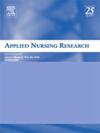紧急传染病大流行下一线护士的压力应对和复原力:潜类分析
IF 2.7
4区 医学
Q1 NURSING
引用次数: 0
摘要
目的本研究旨在使用潜类分析法(LCA)对护理 COVID-19 患者的护士的应对策略和复原力进行分类,并比较这些亚组之间的差异。背景新发传染病的流行对一线护士来说是一种创伤性压力,有可能导致同情疲劳。有效的应对策略和抗压能力对管理压力至关重要,但其细微的分类和结果仍不清楚。方法2022年1月至3月进行了一项横断面调查。结果 共招募了 215 名临床护士(平均年龄 34.59 岁)。三类模型显示出最佳拟合度:第一类(35.8%)为主动应对和高复原力,第二类(29.8%)为混合应对和高复原力,第三类(34.4%)为回避应对和低复原力。与第三类相比,第一类参与者的压力较小(Odds Ratio (OR) = 0.37, 95 % CI: 0.143-0.950, P = 0.039),同情疲劳的风险较低(OR = 0.29, 95 % CI: 1.110-4.536, P < 0.001),辞职意愿较低(OR = 0.39, 95 % CI: 0.175-0.843, P = 0.017)。结论识别这些弱势群体有助于提供干预措施,以减轻压力、预防同情疲劳和戒烟意向。本文章由计算机程序翻译,如有差异,请以英文原文为准。
Stress coping and resilience of frontline nurses under the emergency infectious disease pandemic: A latent class analysis
Aim
This study aimed to classify coping strategies and resilience among nurses caring for COVID-19 patients using latent class analysis (LCA), and to compare variations across these subgroups.
Background
The pandemic of emerging infectious diseases is a traumatic stressor for frontline nurses, potentially leading to compassion fatigue. Effective coping strategies and resilience were essential for managing stress, but their nuanced classification and outcomes remain unclear.
Methods
A cross-sectional survey was conducted from January to March 2022. Purposive and snowball sampling was utilized to recruit participants.
Results
A total of 215 clinical nurses (mean age 34.59 years) were recruited. A three-class model showed the best fit: class 1 (35.8 %) with proactive coping and high resilience, class 2 (29.8 %) with mixed coping and high resilience, and class 3 (34.4 %) with avoidance coping and low resilience. Compared to class 3, class 1 participants had lower stress (Odds Ratio (OR) = 0.37, 95 % CI: 0.143–0.950, P = 0.039), reduced risk of compassion fatigue (OR = 0.29, 95 % CI: 1.110–4.536, P < 0.001), and lower intention to quit (OR = 0.39, 95 % CI: 0.175–0.843, P = 0.017). Class 2 participants, with higher proportion to live with family, had longer work experience, higher income, and also showed significantly reduced intention to quit (OR = 0.386, 95 % CI: 0.168–0.887, P = 0.025).
Conclusions
Identifying these vulnerable groups can help in providing interventions to reduce stress and prevent compassion fatigue and intention to quit.
求助全文
通过发布文献求助,成功后即可免费获取论文全文。
去求助
来源期刊

Applied Nursing Research
医学-护理
CiteScore
4.50
自引率
0.00%
发文量
65
审稿时长
70 days
期刊介绍:
Applied Nursing Research presents original, peer-reviewed research findings clearly and directly for clinical applications in all nursing specialties. Regular features include "Ask the Experts," research briefs, clinical methods, book reviews, news and announcements, and an editorial section. Applied Nursing Research covers such areas as pain management, patient education, discharge planning, nursing diagnosis, job stress in nursing, nursing influence on length of hospital stay, and nurse/physician collaboration.
 求助内容:
求助内容: 应助结果提醒方式:
应助结果提醒方式:


